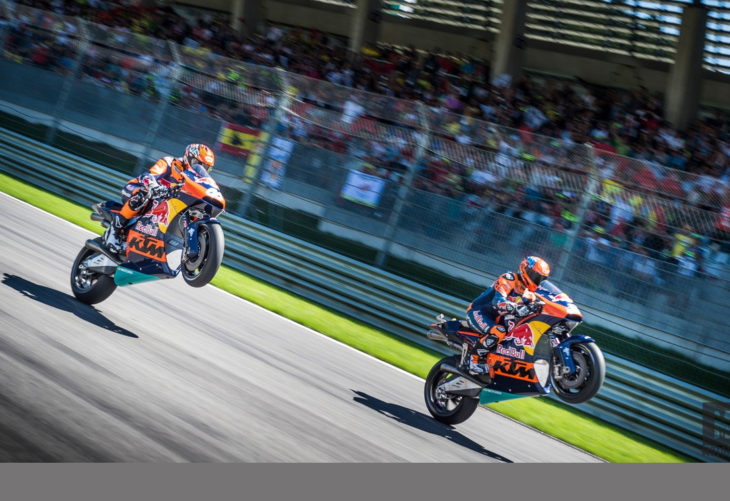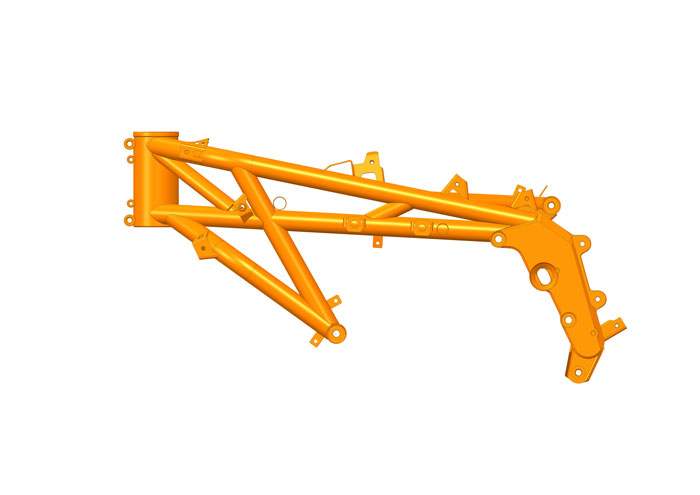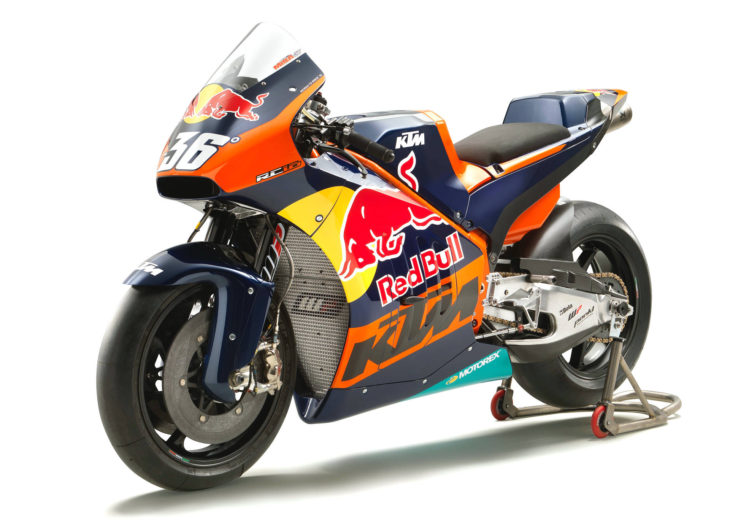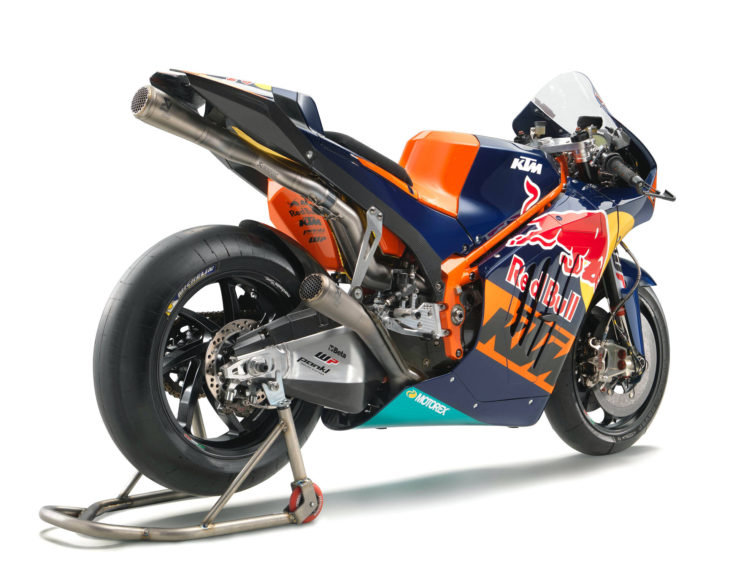The fire breathing beast from KTM (claimed 270 hp) was officially unveiled at the Austrian MotoGP round last weekend with test riders taking demo laps in front of the crowd.
Next year, KTM will be racing full-time in MotoGP with riders Pol Espargaró and Bradley Smith, and according to the crew chief for the RC16 project, the RC16 was just two seconds off the best laps posted by MotoGP regulars at the recent Austria test.
One interesting aspect of the RC16 is its use of a steel-tube chassis, unlike the other MotoGP race bikes which use aluminum. The cold-formed, high-strength steel tubes have a very small weight penalty when compared to aluminum, and are ultimately much stronger than the competing material, according to KTM’s supplier. In photos, the chassis seems to nestle the V-4 engine in a very compact, narrow package. Ducati had some success with a steel trellis frame in MotoGP several years ago, so steel can definitely work if done right.
Take a look at the video below discussing the new machine.
See more of MD’s great photography:










They’ll likely need a few years of data collection to be a true threat, but I expect KTM to come out swinging. Glad to see them on the grid.
re: “One interesting aspect of the RC16 is its use of a steel-tube chassis, unlike the other MotoGP race bikes which use aluminum. The cold-formed, high-strength steel tubes have a very small weight penalty when compared to aluminum, and are ultimately much stronger than the competing material”
gotta USP somethin’.
Glad to see you back Norm!
I didn’t see any mention of a seamless shifting transmission.
Anyone know how this compares to Suzuki 6 months prior to their entering motogp? While 2 seconds a lap sounds like a lot, there’s still a lot of development time. I wouldn’t expect KTM to run with the front 8 riders or so in there first season, but hopefully once they have a season under their belt they get competitive. Similar to what Suzuki has done. You need an alien pilot to run at the front.
Re: “You need an alien pilot to run at the front.”
At this level, all the riders are aliens. Ducati and Suzuki have both occasionally out-qualified the factory Honda’s and Yamaha’s showing that their riders are capable of the fastest lap times. The consistency of the bikes themselves is the obstacle to winning at race distance.
There’s aliens, and then there’s Rossi, Marquez and Lorenzo aliens.
Lol. A new class: superaliens!
Excellent effort KTM ,It is amazing how many haters are out there, not having a clue about what it takes to develop a bike and compete at this level,
Ah yes, the “Haters” are out there, probably at Sturgis, but most here are enthusiasts. This is really cool engineering by KTM.
Hang on a minute, 270HP isn’t at the level of the other guys and it’s at least 40HP down on the Ducatis. I mean sure no one states their official outputs but they’ve all been pushing 300 for a while now.
http://m.crash.net/motogp/news/232254/1/casey-stoner-the-first-time-ive-pushed-in-years.html
That would explain at least part of the 2 second deficit, no?
you sure he’s not talking 310 KMPH (193 mph) and not horsepower? I thought the GP bikes were putting out about 250 hp
http://www.motorcycledaily.com/2012/03/1000cc-honda-moto-gp-bike-puts-out-more-than-250hp-according-to-satellite-team-lcr/
Recent reports I’ve read puts Marquez’s Honda at 270 HP
If Ducati’s really have 310 HP and Marquez and Lorenzo only have 270, you’d think there would be a larger disparity in top sppeds than what we are seeing. DOvi has the record at 218 just ahead of Pedrosa at 217 mph I believe
I believe Italian horses are somewhat smaller.
Law of diminishing returns?
I remember when I started racing motocross in 1972 the Spanish Bultaco 250s were reportedly producing 45 hp and the Yamaha MX250 was putting out a reported 29 yet the Yamaha was faster. WE determined the Yamaha hp was rated at the rear wheel and the Bultacos hp was rated at the wrist pin lol.
re: “If Ducati’s really have 310 HP”
they do not. Desmo’s good, but it ain’t THAT good. and last I checked the rev limit was capped at 18,000…? the “GP nannies” may have even dropped it…? dunno.
so the only way you can get to that number normally aspirated, on pump gas, and only 1 Liter of swept volume is either to A, rev it out. or B, forced induction.
see “Kawipedia” entry for Ninja H2R.
I don’t know where the Norm’s been and in fact I’ve disagreed with some of his points, but damn glad you’re back sir
Chassis setup and suspension action has a huge impact on how much of that power is put to use driving the bike forward. Yamaha and Honda have a better chassis than Ducati, so they still have a more competitive bike overall unless the track has huge straightaways or a lot of non technical turns.
Going back to KTM, traditionally their motocross bikes always made class leading horsepower but chassis and suspension was their Achilles heel. Hence the informal acronym “keep the motor.” In recent years they have really stepped up their game in the chassis and suspension side of thing and their bikes are way better all around than they were in the bad old days.
Re: “Chassis setup and suspension action has a huge impact on how much of that power is put to use driving the bike forward.”
We laypeople don’t even know what that means in MotoGP terms, but the aDucati has shown to have a tremendously good chassis, routinely beating the majority of the Hondas and Yamaha’s on track, which could not happen no matter who was in the saddle if the chassis were inferior.
KTM will do well. They know what they’re doing.
You’re right. It’s just as likely that the traction control, or even having a bit lesa power is helping Yamaha and Honda do better on the tighter more technical tracks.
I can’t tell if my vision is playing tricks on me, if it’s just the simple feont fairing or what, but the forks on the ktm look pretty long compared to the other brands.
Those are some serious front brake rotors.
Always good to have another manufacturer in Moto GP. Unfortunatly two seconds a lap slower than the front runners means that they will be dicing at the back of the field.
KTM’s problems won’t be on the mechanical front. Ready to race is their credo for good reason. It will be coming to terms with the electronics package and a lack of data that will be the stone in their shoe. And the ever changing tires each new season.
It’s easy to take a good package then refine it one piece at a time. Making a couple dozen design changes simultaneously is like pissing in the wind. You can’t tell which single change made the positive difference or are other changes taking you a step back. That takes time that KTM doesn’t have the luxury of.
But I think they’ll be like Suzuki. It’ll handle well from the start, but the KTM will have the power from the get go. Controlling it will be the challenge the first season. Even Suzuki has upped their ante this season. look at how well Mav did in the Austria race, keeping pace with Marquez (even though he was injured, still a feat).
As I recall Ducati abandoned the welded steel tube frame because they could not make them all exactly the same. The hand welded joints it seems varied quite a bit and so that critical amount of flex varied which provides the ‘feel’ riders rely on was not consistent bike to bike making their job much more difficult. Why the aluminum frames avoided this I have no clue. Generally there is a good reason when all teams opt for certain basic designs. I might be wrong on that detail about the welds and sometimes a departure from the norms leads to success but I’m wary this is the way to go.
You’re not wrong. I’m an engineer, but cut my teeth as a welder and machinist a few decades ago. Ducati did have a difficult time getting each frame to be exactly the same. Stoner always stated that each bike felt different even when adjusted exactly the same.
Tubes can be cut with excellent precision but bending and welding imparts a lot of internal stresses from all that heat. It distorts the assembly and it shrinks when it cools, even when properly post-weld heat treated. Then to get the intended properties back, it needs to be stress relieved which causes more shrinkage and distortion. The only way to get any precision is to do most of the machining post weld.
The aluminum framed GP bikes avoided all kinds of inconsistencies because the frames are machined from billet so they have the utmost precision. Even being aluminum, you still need to watch the heat created during machining and use good fixturing.
I personally love the feel of a steel frame, extra weight be damned. As a road and mountain cyclist, the aluminum frames were stiff and therefore harsh. My current carbon frames feel better and are lighter still, but the steel still beats it for feel and long term comfort.
On a motorcycle, aluminum frames are great for strategic strengthening and component mounting but are bulky, making it difficult as hell to access anything for maintenance. I hate doing any kind of maintenance or repair on the CRF450X and Ninja 1000. Especially carb work on the 450. I use a lot more curse words on those bikes than my pre-02 Buells and HD.
re: “aluminum frames were stiff”
re: “but are bulky”
they’d better be or you and I are going to be in a world of hurt. as you well know, the achilles heel of Al is it’s fatigue strength (or lack thereof). let if flex at the wrong frequency and you’ll have problems in short order. there is no force so small that will NOT fatigue aluminium. in the context of Al, Obi-Wan Kenobi is wrong, the “FORCE is not with you Luke”…
it’s AGAINST YOU…!!!
Your Star Wars reference go me thinking, if SpaceX can 3D print rocket engines then how long before a MotoGP team prints a frame? Wouldn’t that be the ultimate?
re: “As I recall Ducati abandoned the welded steel tube frame because they could not make them all exactly the same.”
close, that’s what you were TOLD. you then simply went with it, basing all rationale off that single assumption going forward, fullstop.
re: “I might be wrong”
no might about it.
re: “I’m wary this is the way to go”
no worries, you’re only wary because you have no knowledge of the 20 years of Ducati racing History that records 28 championships, won by 16 different riders, using 4 different steel frame designs, across 4 different championships. never once was a complaint of “frame inconsistency” and “set up” issues heard. one can only assume (logically) they were simply too busy crossing all those various and sundry finish lines in P1 to give it much consideration.
note, ALL of these frame styles (ie. 851, 916, 999/1098) except for one (the half-framed D16) were production, and NONE of these frames were anything special in terms of the tubing grade used or welding technique applied. they were low-cost and decidedly “unsophisticated”. they weren’t even arc welded. you only see arc on the first MKI MV’s, but those with ATD (attention to detail) will have noticed latest kit like the F3 has STOPPED the practice (OMG).
so see, don’t be FOOLED by “illusions of progress”. we’re only dealing with 2 wheels here, any engineer worth his resume will tell you, just because something is touted as being “more advanced”…? or is “new and improved”…? it does not necessarily follow that it is. 9 times outta 10, those words originated from “ad copy” and a “belief system” generated by somebody’s Marketing Department, NOT from us boffins in R&D.
Yea +. Another competitor in MotoGP is great news and it has a trellis frame on top of that too! Something a little different that, if successful, may allow other teams to experiment with their frames. KTM will also field a team in Moto2 with their own chassis giving them a strong presence in all three classes.
One of those days that you wonder why about something I saw the aluminum designation in my mountain bike… 7005… and then I wonder about the aluminum used on bikes… I only found information about the frame on the GoldWing… 6005.
It happens that the first criteria for selection of aluminum in bikes (and mountain bikes) is how good they weld.
Steel provides a more compact frame, more space to handle through and other benefits as damping, easier to weld, as well as a longer life span than Aluminum… so why aluminum?
The best answer I found was that it looks nicer… and you know looks sell.
—————
No engine-frame pron photos?
Vibrations in aluminum decay about 3X faster than an equivalent structure in steel, all other things being equal.
This new frame is bolted to a big assembled hunk of aluminum (the motor), so that will help.
270 HP: can’t wait to see where this bike is vs. its peers at the end of the straights!
I would love the orange team to speed up the surprises section, but it’s probably going to take them some time.
On one hand they have to have the machine, on the other hand the rider.
Maybe the buyers get the surprise in the form of a trickle down V4?
—————–
It’s me or the fairing looks… well… simple? a little bit boxier but not RC8-angular.
I figure one second is the rider, the other second is the bike. At the limit, both are tough to improve, but doable. It will be a good show, I’m gonna watch it.
Not sure when Bart got his misinformation about steel and vibration dampening but he’s incorrect about it. Aluminum structures as in GP frames are severely stiff and propogate vibes from very low to very high frequencies with no dampening whatsoever. You feel everything.
On the other hand, that’s a good thing when trying to strategically control flex without going into hysteresis which can rip a frame apart as the amplitude of the vibrations at a given frequency increase out of control. This is why, on street bikes, you’ll find engines either isolation mounted or rubber mounted. For comfort and durability.
Re: your MTB… 7005 for a long time had been reserved for race frames, like the GT Zaskar LE I had 2 decades ago. 6061 was more common, less expensive and took anodizing much better. And it felt better over a long time in the saddle.
On a street bike, I would choose a 2014 aluminum over anything else. High degree of ductility makes it comfortable and durable with all the stresses a high HP engine and road conditions can throw at it. But for the same feel, less money and a weight penalty, steel tubing gets you the same performance characteristics.
I’d like to see more steel offerings out there. I may have to by a KTM Duke someday. Just as ugly as my Buells but twice as good.
As to why aluminum vs steel…
Cost and production numbers. Aluminum frame halves can be cast cheap as chips. You can also consolidate features into it instead of having a bunch of loose parts, bolted on brackets and such and you can control performance through strategic thicknesses and shapes.
Steel frames are time consuming, require lots of post-weld processing and are costly to make, not to mention lack the accuracy and consistency of a precision casting.
Wow, thanks for taking that much time for your response.
Rapier point above about all of them being similar as well as yours are indeed interesting, I din’t thought about “making them all the same” and even worst “feel the same” factor.
” I may have to by a KTM Duke someday. Just as ugly as my Buells but twice as good.” Pure gold.
Damn good read and info Bob K. Thank You very much!
re: “not to mention lack the accuracy”
accuracy is over-rated.
7005 was a more expensive material than 6061 but the main reason bicycles used it was because it did not require post-weld heat treating like 6061 does. 6061 is widely used today because most bikes are made of aluminum, bringing the cost of heat treatment down with volume.
2014 is excellent for components because it is strong, takes extruding & forging well, but it doesn’t weld so they generally don’t make frames out of it.
Bob, I got my information regarding the damping properties of steel vs. aluminum from a lifetime of experience as a mechanical engineer designing and testing all sorts of machines made from all kinds of materials. The longitudinal loss factor for aluminum (one measure of material damping) is .00003 to .0001, for steel .0002 to .003. I’ve done the dynamic testing and measured the damping properties for several machines in steel and aluminum, and stand by my comments.
I agree aluminum race frames are stiff, they are designed that way. But it doesn’t change the basic property of the materials used, only the way they are employed. It’s really hard to compare aluminum apples to steel oranges, but now we have a chance to see if KTM is on the right track, so to speak! Oh yeah, if you get the chance, ride a big Duke if you haven’t already, amazing bike! Blows my 950 into the weeds!
re: “but now we have a chance to see if KTM is on the right track”
we’ve already seen this movie (well some of us).
Hysteresis occurs with any amount of flexion, it is the energy lost in the form of heat when a material is flexed and is not itself a stress or force on the material. Are you thinking of dramatically increased vibration at a resonant frequency?
re: “It happens that the first criteria for selection of aluminum in bikes (and mountain bikes) is how good they weld.”
it happens that the first criteria for selection of aluminium in “motor” bikes is LABOR AND MATERIAL COSTS.
the 2nd criteria is PROFITS, oh wait, maybe that’s the first…?
KTM’s entry into Motogp seems serious and well thought out. I hope they will be competitive in short order. The more competition the better. It is a beautiful machine as well in the KTM-Red Bull colors. And 270 hp, wow indeed.
It would bother me a bit if MotoGP went the same way as Formula 1, with energy drinks out-financing the actual bike builder. You cannot tell who builds the engines in modern F1 cars. The only recognizable logo is Red Bull or Air India, etc. I hope Yamaha, Honda, KTM, Ducati, Suzuki, etc., continue to be title sponsors for these teams. Keep the “motor” in motor racing.
Would agree with that. I traveled to Watkins Glen every year back in the days when F1 was still a sprint race and not a variation of NASCAR with fuel and tire stops. The cars were beautiful in their team colors and you could tell Fords from Brabhams from Ferraris just by the sound. Today’s F1 is about as exciting as watching paint dry.
It’s all about money (sometimes very unfortunately). I know what you mean, I watch motor sports to see the teams and, well, the motors. I like to see what the engineers have cooked up under the hood. That’s a big reason I’m less in favor of the playing field when it’s leveled just to make for close racing. If I want close racing I can go to the carnival and watch the cars and motorcycles (and fire engines and police cars) go around and around. I know I may be the minority in this but I really enjoy seeing what the engineers come up with each year. Somehow watching energy drink vehicles isn’t the same.
Re: “It would bother me a bit if MotoGP went the same way as Formula 1, with energy drinks out-financing the actual bike builder. ”
I think we’ve already been there for a long time. The only reason we know who made which bike today is because of our own familiarity with the teams. Orange Repsol Honda’s? Black Tech3 or Blue Fiat Yamaha’s? Only Ducati and Suzuki race in their brand’s color and you can bet they’re working hard behind the scenes to get someone else to pick up that bill. Without reasonably controlled costs, this will continue to be the case. MX has done a little better to curb that and factories generally don’t bring on much more than a partnership level of sponsor, leaving us with Red Hondas, Blue Yamaha’s, Green Kawasaki’s, etc..
The racing needs to be regulated though. No form of racing with wide field disparity has ever been successful and sustainable. Besides, it’s in close, regulated racing that real engineering genius appears (who can find performance within strict boundaries), otherwise it’s just wallet racing and nobody really wins at that.
There is much less area on a motocross bike for advertising than a fully faired roadracer. If the factories could sell the space for big dollars they would.
The largest area on a motocrosser for advertising is the rider, not the bike. How many pro riders do you see wearing motorcycle logo riding gear?
The MX guys currently sell that space to Monster, Red Bull, Geico, Toyota, and others. The MX GP riders used to sell the whole package to tobacco companies (Chesterfield). It’s not the size/space, it’s the potential viewership that sponsors are after.
yea, what he said.
270 hp wow
Best of luck to KTM going forward.